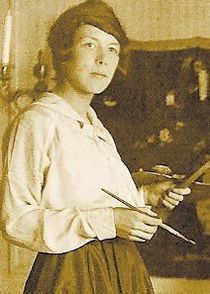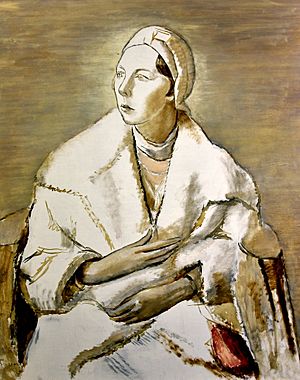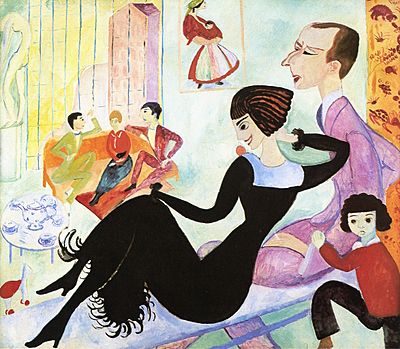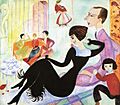Sigrid Hjertén facts for kids
Quick facts for kids
Sigrid Hjertén
|
|
|---|---|

Sigrid Hjertén at work
|
|
| Born | 27 October 1885 |
| Died | 24 March 1948 (aged 62) |
| Nationality | Swedish |
| Known for | Painting |
| Movement | Modernism |
Sigrid Hjertén (born October 27, 1885 – died March 24, 1948) was an important Swedish modernist painter. She is known as a key artist in Swedish modern art. Sigrid Hjertén was very creative and showed her art in 106 exhibitions. She worked as an artist for 30 years. She passed away due to complications from a serious illness.
Contents
About Sigrid Hjertén
Sigrid Hjertén was born in Sundsvall, Sweden, in 1885. She studied at the University College of Arts, Crafts and Design in Stockholm. She became a drawing teacher. In 1909, Sigrid met Isaac Grünewald at a party. He was a young artist who had studied with Henri Matisse in Paris. Isaac encouraged her to become a painter.
Later that year, Sigrid also went to Matisse's art school. People said she was Matisse's favorite student. This was because she had a wonderful sense of color.
Her Art Style in the 1910s
When Sigrid Hjertén studied with Henri Matisse in Paris, she was very impressed. She learned a lot from how he and Paul Cézanne used color. Sigrid developed her own style. She used strong, contrasting colors and simple shapes. Her main goal was to show feelings through color. She even described colors like "cold yellow" in her later works.
Sigrid wanted to find ways to express her emotions. Her art was more like German Expressionism. Artists like Ernst Ludwig Kirchner also focused on feelings. This was different from the French painters, who often used graceful lines.
After about a year and a half, Sigrid returned to Sweden. In 1912, she had her first art show in Stockholm. Over the next ten years, she showed her art many times. She exhibited in Sweden and other countries, including Berlin in 1915. Her work was well-received there. She also showed her art at the Expressionist Exhibition in Stockholm in 1918. However, critics in Sweden at the time did not always like her art.
Sigrid Hjertén's art shows how she grew as an artist. Matisse's influence is most clear in the 1910s. During this time, she painted many indoor scenes. These often showed views from her home in Stockholm. Her husband Isaac, her son Ivàn, and Sigrid herself often appeared in these paintings. These scenes sometimes showed different kinds of feelings or conflicts. Sigrid also found inspiration from the art of Ernst Josephson during his illness.
Ateljéinteriör (Studio Interior)
Ateljéinteriör (Studio Interior) is a famous painting from 1916. It shows how modern Sigrid Hjertén was for her time. The painting explores her different roles. She was an artist, a woman, and a mother. Sigrid sits on a sofa between two artists. One is her husband, Isaac Grünewald. They are talking over her head. Sigrid's large blue eyes look far away.
In the front, a woman in black leans against a male figure. This woman might be a different side of Sigrid. Her son Ivàn is crawling from the corner. In the background, you can see one of Sigrid's other paintings. It is called Zigenarkvinna (Gypsy Woman). This painting, along with Den röda rullgardinen (The Red Blind) from 1916, are bold works. They help us understand more about the artist's life.
Life and Art in the 1920s
From 1920 to 1932, Sigrid Hjertén and her family lived in Paris. They often traveled to the French countryside and the Italian Riviera to paint. This was a peaceful time for Sigrid's art. However, she did not have many exhibitions during these years. Her husband often visited Stockholm for his successful career. In the late 1920s, Sigrid started to feel unwell. She also felt lonely.
Over time, her art began to show more tension. In the late 1920s, she felt very isolated in France. Her paintings started to use colder and darker colors. Repeating diagonal lines in her art also made the paintings feel more intense.
The 1930s and Later Life
In 1932, Sigrid Hjertén decided to move back to Stockholm. But she became very ill while packing. She returned to Sweden and was cared for at a hospital. She got better for a while. In the next two years (1932–1934), Sigrid's art reached a peak. She painted with great energy, creating many pictures. She called them "the picture-book of her life."
Her paintings from this time often show dark feelings. They feature stormy clouds and feelings of being alone. Some paintings look scary, while others feel warm and peaceful.
In 1934, she traveled with her family in southern Europe. She continued to paint there. Sigrid finally became known among art critics in 1935. This happened when she exhibited with Isaac in Gothenburg. Still, many critics at the time did not like her art. Some wrote very harsh reviews. They called her paintings "idiocy" or "horrors."
She gained public recognition in 1936. She had a successful solo exhibition at the Royal Swedish Academy of Arts in Stockholm. Critics praised her after seeing nearly 500 of her works. They called her one of Sweden's most original modern artists. She finally got the recognition she deserved, but it was late in her career.
Isaac divorced Sigrid and remarried. He and his new wife later died in a plane accident in 1946.
In the late 1930s, Sigrid Hjertén was permanently hospitalized due to her illness. She stayed there for the rest of her life. After 1938, she painted less and less. She passed away in Stockholm in 1948 due to medical complications.
Her Artistic Legacy
Sigrid Hjertén created more than 500 paintings. She also made many sketches, watercolors, and drawings. Throughout her career, Sigrid had to deal with the ideas of her time. Her paintings feel very personal for when they were made. At that time, artists often focused on color and shape.
Sigrid was very interested in people. This often showed in her dramatic paintings. She used color to express both feelings and ideas.
Images for kids
See also
 In Spanish: Sigrid Hjertén para niños
In Spanish: Sigrid Hjertén para niños






